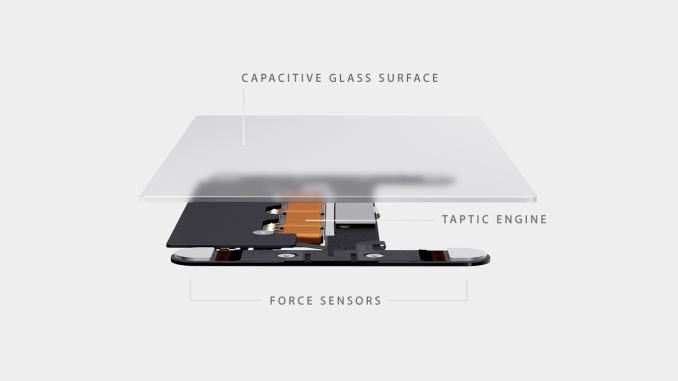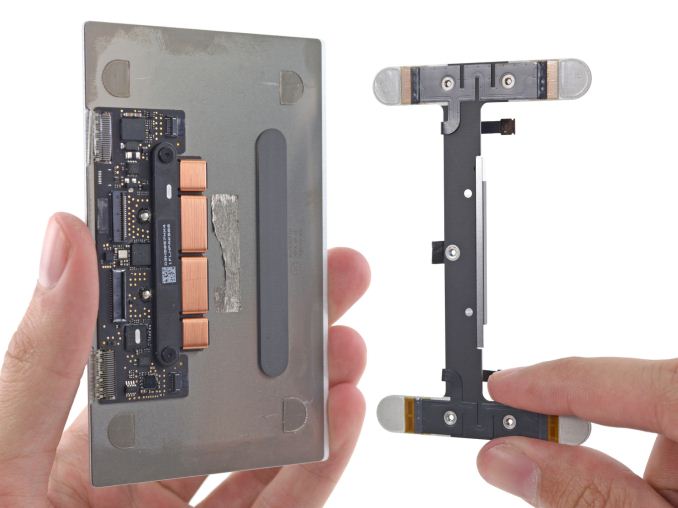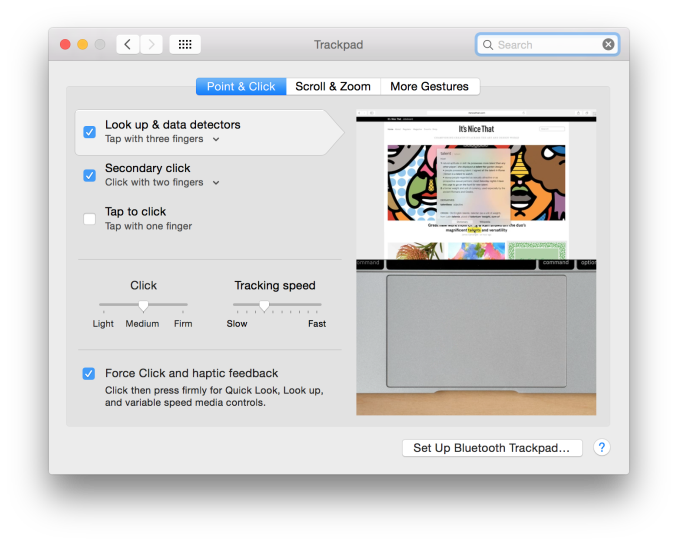The 2015 MacBook Review
by Ryan Smith on April 14, 2015 10:15 AM ESTForce Touch Trackpad
Along with Apple’s changes to their keyboard, the company has also gone in and significantly reworked their trackpad. The new Force Touch Trackpad represents the biggest change to Apple’s trackpad design since the creation of the capacitive, multi-touch pivoting trackpad introduced on the unibody MacBook Pro. In putting together the Force Touch Trackpad, Apple has significantly reworked the internals of the trackpad, creating a trackpad that behaves a lot like their traditional trackpad with some new features, but under the hood relies on some very different mechanisms.
The big change here is that Apple has done away with the traditional pivot and switch mechanism. With pivot and switch, the capacitive trackpad surface would act like a small touchscreen, and underneath it was a switch to register when the trackpad was pressed down. Mechanically the trackpad pivoted from the top (Apple likes to compare it to a diving board), with the trackpad inferring what action to take based on the combination of the capacitive readings and the switch reading. Multi-finger gestures would rely solely on the capacitive layer, primary/secondary clicks would be based on the number of fingers in use when the switch was actuated, etc.
The Force Touch Trackpad on the other hand eliminates the pivot and switch mechanism in favor of a combination of an electromagnet and force/pressure sensors. The pressure sensors essentially replace the physical switch, allowing the trackpad to tell when it has been pressed based on the amount of pressure, and thanks to the pressure sensors it can now tell how hard it has been pressed as opposed to the binary nature of the physical switch. Meanwhile without a physical switch in place to provide the clicking sensation and feedback of pressing down on the touchpad, Apple’s electromagnet – the Taptic Engine – activates to simulate the feeling and noise of pressing a switch.
Update 04/15/2015: iFixit has a great shot of the trackpad's internals, including a good look at just how big the electromagnet/taptic engine really is.
The end result is that the MacBook’s trackpad is among the first wave of devices that ships with Apple’s next generation trackpad and the enhanced capabilities that go with it. Ignoring the pressure sensitivity for a moment (we’ll get back to it), replacing the pivot and switch for an electromagnet works shockingly well. From a touch & feel standpoint the Force Touch Trackpad feels virtually identical to a traditional trackpad, to the point where it’s more than a bit uncanny. In practice you are not actually triggering a switch nor is the trackpad really moving (technically it’s deforming ever so slightly), but it sure feels like you’re working a switch. Apple has clearly done their homework on getting an electromagnet to emulate a switch, to great results. Meanwhile they don’t have the trackpad’s acoustics precisely matching a switch, but the resulting pinball-machine like plunk is close enough to a click that I don’t imagine anyone will mind the difference.
One side benefit of this change is that the trackpad feels the same throughout, and unlike the pivoting trackpad does not require more or less force depending on where you are relative to the pivot point. The variable force required has never been a major problem in my experience, but it is nice to no longer need to worry about where your fingers are relative to the top, and consequently how much force you need to use.
However the bigger deal is that by making the amount of force required to click consistent throughout the entire trackpad, Apple can now use the amount of pressure applied as another input, making the trackpad pressure-sensitive. The underlying pressure sensors and electromagnet are by default programmed to have two levels of feedback – a shallower press is equivalent to a click – and a deeper press brings about the pressure-sensitive “Force Click.” What force clicking does depends on the application, and right now it’s clear that Apple is still experimenting with what they can do with pressure sensitivity. The most obvious uses include line thickness in drawing applications, but the company is also using it for things such as variable speed fast forward and rewinding in QuickTime/iMovie. At times the force click is treated like a 3rd (tertiary) click, and other times the result is based on variable pressure. Since this is a new (and uncommon) feature there’s no global action assigned to the force click – nor does it behave as a middle click on a regular mouse – so what happens is up to the application.
In implementing force click and the Force Touch Trackpad, Apple does offer the ability to control the amount of pressure required and whether force click is active. With force click deactivated the trackpad behaves more or less identical to a traditional trackpad with a single click level. Meanwhile the click pressure setting is interesting, though I’m not entirely convinced it’s all that effective. Short of the tools to actually measure click pressure, I’m not so sure Apple is changing the amount of pressure required to trigger a click so much as they’re changing how hard the electromagnet vibrates. The feedback change is certainly very subtle going from light to firm, and if there is a change in the amount of pressure required then it is certainly equally subtle.
Ultimately whether the Force Touch Trackpad is a major upgrade or not is going to depend on a user’s ability to make use of the force click features. Even turned off, the new trackpad is essentially an improved version of the old trackpad without the minor drawbacks of the pivot mechanism. But with the force click turned on, then it brings new (though not always useful) actions to the trackpad that in turn makes it a bigger upgrade over the old trackpad.
In any case, the MacBook along with the 2015 MacBook Pro 13” are the first wave of devices to implement the new Force Touch Trackpad. Given its expanded capabilities I would expect Apple to eventually replace many (if not all) of their trackpads with this new design. Certainly the 15” MacBook Pro is a likely candidate, as is a future version of the Magic Trackpad. What remains to be seen is whether the next MacBook Air also gets this new trackpad, or if Apple withholds it to keep the products differentiated and to keep the costs of the MacBook Air down.














354 Comments
View All Comments
pliablemoosethebanned - Sunday, June 21, 2015 - link
Ryan, great article, I just got a MacBook, my use case (trading stock options at work during my lunch and breaks) is perfect for this laptop, I commute on the subway and via electric skateboard, and weight savings is important.I tried to use my iPad and find a touch screen is pretty miserable to choose options, same goes for a phone, tried the best Chromebook and the keys started falling off in the first week. (Toshiba Chromebook 2 with the 1080 screen), loved the screen, but the rest of the hardware just didn't cut it. $1K for a Pixel is just a bit too much for a Chromebook, but it was tempting, would have been a sale for Google had they included LTE.
This is day one with the MacBook, hope it stands up.
cyrenaichedon - Friday, August 7, 2015 - link
"if not for the fact that Apple took the time to point this out in their reviewer’s guide"Yeah, the numbers look impressive but in reality, it feels like your typing on a flat surface.
hot kiwi - Wednesday, November 25, 2015 - link
So, I have bought this expensive piece of equipment, having been an apple fan since a decade and all equipment at home from iPhones to the Time capsule and and and from Apple.Well, because of this notebook it is my last Apple product. this MacBook is a waste of money and a nuisance. i arrive at work and have forgotten to take my 30 $ separate adapter with me, so cant not upload my presentation to a USB stick. I wanted to put a large spreadsheet from the computer to a USB drive, but the computer was almost empty on charge, so could not download and charge at the same time. the keyboard is purely experimental and you make type after types due to its minimal action.
Mark my words: Apple made a huge mistake with this product that gave away all the functionality for a minimal weight gain.
Now that Samsung and Microsoft have more than caught up, it is time to make the switch.
never Apple again after this failure.
cinaski33 - Sunday, June 19, 2016 - link
When you buy something you usually pay attention at what you really need. Apple doesn't just the new macbook, but also the macbook pro, that has everything you need for every use and connection.There's no Dell Xps or other good product that can fit your needs if you need something else. Apple has always been forward, and every other company tried (sometime better, sometime worser) to copy.
If anyone had problem and complained about port lack or cpu power (that works fine anyway like other thin notebook thank to the OS X system) it's just for wrong choice.
I have my 13 inches 2015 macbook pro Retina with 16gb ram and 512 hd, payed 1400€, and it kills the Lenovo X250 or the Dell XPS.
So do yourself a present.
Think before buying.